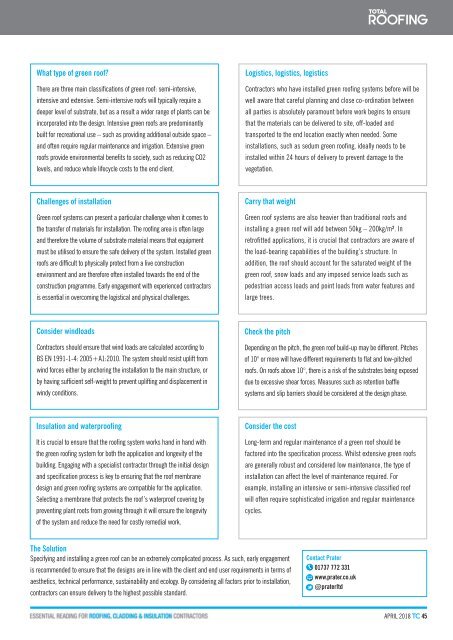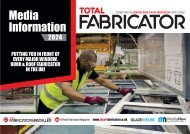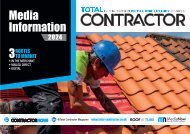April 2018
You also want an ePaper? Increase the reach of your titles
YUMPU automatically turns print PDFs into web optimized ePapers that Google loves.
What type of green roof?<br />
There are three main classifications of green roof: semi-intensive,<br />
intensive and extensive. Semi-intensive roofs will typically require a<br />
deeper level of substrate, but as a result a wider range of plants can be<br />
incorporated into the design. Intensive green roofs are predominantly<br />
built for recreational use – such as providing additional outside space –<br />
and often require regular maintenance and irrigation. Extensive green<br />
roofs provide environmental benefits to society, such as reducing CO2<br />
levels, and reduce whole lifecycle costs to the end client.<br />
Logistics, logistics, logistics<br />
Contractors who have installed green roofing systems before will be<br />
well aware that careful planning and close co-ordination between<br />
all parties is absolutely paramount before work begins to ensure<br />
that the materials can be delivered to site, off-loaded and<br />
transported to the end location exactly when needed. Some<br />
installations, such as sedum green roofing, ideally needs to be<br />
installed within 24 hours of delivery to prevent damage to the<br />
vegetation.<br />
Challenges of installation<br />
Green roof systems can present a particular challenge when it comes to<br />
the transfer of materials for installation. The roofing area is often large<br />
and therefore the volume of substrate material means that equipment<br />
must be utilised to ensure the safe delivery of the system. Installed green<br />
roofs are difficult to physically protect from a live construction<br />
environment and are therefore often installed towards the end of the<br />
construction programme. Early engagement with experienced contractors<br />
is essential in overcoming the logistical and physical challenges.<br />
Carry that weight<br />
Green roof systems are also heavier than traditional roofs and<br />
installing a green roof will add between 50kg – 200kg/m². In<br />
retrofitted applications, it is crucial that contractors are aware of<br />
the load-bearing capabilities of the building’s structure. In<br />
addition, the roof should account for the saturated weight of the<br />
green roof, snow loads and any imposed service loads such as<br />
pedestrian access loads and point loads from water features and<br />
large trees.<br />
Consider windloads<br />
Contractors should ensure that wind loads are calculated according to<br />
BS EN 1991-1-4: 2005+A1:2010. The system should resist uplift from<br />
wind forces either by anchoring the installation to the main structure, or<br />
by having sufficient self-weight to prevent uplifting and displacement in<br />
windy conditions.<br />
Check the pitch<br />
Depending on the pitch, the green roof build-up may be different. Pitches<br />
of 10° or more will have different requirements to flat and low-pitched<br />
roofs. On roofs above 10°, there is a risk of the substrates being exposed<br />
due to excessive shear forces. Measures such as retention baffle<br />
systems and slip barriers should be considered at the design phase.<br />
Insulation and waterproofing<br />
It is crucial to ensure that the roofing system works hand in hand with<br />
the green roofing system for both the application and longevity of the<br />
building. Engaging with a specialist contractor through the initial design<br />
and specification process is key to ensuring that the roof membrane<br />
design and green roofing systems are compatible for the application.<br />
Selecting a membrane that protects the roof’s waterproof covering by<br />
preventing plant roots from growing through it will ensure the longevity<br />
of the system and reduce the need for costly remedial work.<br />
Consider the cost<br />
Long-term and regular maintenance of a green roof should be<br />
factored into the specification process. Whilst extensive green roofs<br />
are generally robust and considered low maintenance, the type of<br />
installation can affect the level of maintenance required. For<br />
example, installing an intensive or semi-intensive classified roof<br />
will often require sophisticated irrigation and regular maintenance<br />
cycles.<br />
The Solution<br />
Specifying and installing a green roof can be an extremely complicated process. As such, early engagement<br />
is recommended to ensure that the designs are in line with the client and end user requirements in terms of<br />
aesthetics, technical performance, sustainability and ecology. By considering all factors prior to installation,<br />
contractors can ensure delivery to the highest possible standard.<br />
Contact Prater<br />
01737 772 331<br />
www.prater.co.uk<br />
@praterltd<br />
APRIL <strong>2018</strong> TC 45

















